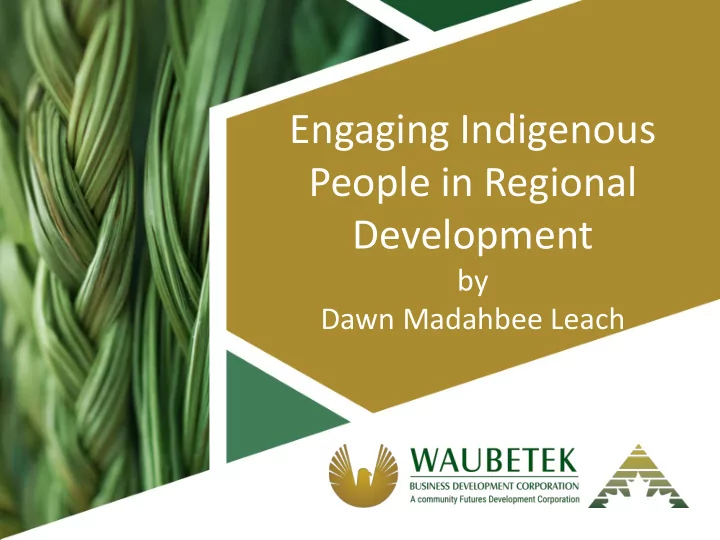

Engaging Indigenous People in Regional Development by Dawn Madahbee Leach
First Nations in Ontario • Ontario has the largest population of First Nation people in Canada ( 158,400 or 22.6% of Canada’s total First Nation population) • Aboriginal people represent 13% of Northern Ontario’s population ( 25% in next generation ) • First Nation people represent 1.5% of Ontario’s total population • 2 nd largest # of First Nation communities in Canada – 130 • 105 First Nations located in Northern Ontario • First Nation population is growing 4x’s rate of Canadian population
Ontario’s massive Far North landbase is primarily populated by First Nations People
THE STATE OF THE INDIGENOUS ECONOMY IN CANADA • Growing Population • Increased number of Post-Secondary Graduates • Expanded Land and Resource Bases • New Legislation • Involving Indigeous People in Regional Development • Economic Reconciliation
Growing Indigenous Population • The Indigenous population grew 3.6% between 2006 and 2011, 4x’s faster than the Non -Indigenous population – 1.4 million in Canada • 400,000 Indigenous youth are projected to enter the labour market by 2026, with potential to meet Canada’s future labour market needs. • There is an opportunity to increase Indigenous participation while addressing the growing demand for skilled workers in transportation, health and resource sectors
Increased # of Aboriginal Post-Secondary Graduates • 2 out of 5 First Nation adults have a post-secondary education • Parity exists between First Nation and Non- Aboriginal people with trades certificates (12% and 13% respectively) • While younger Aboriginals have higher education levels, gap still exists with mainstream (-20.6%) • Educated Aboriginals also knowledgeable of culture and issues
First Nations and Land • Strong traditional attachment to the lands • Substantiated legal claims of land misappropriation, expropriation, boundaries wrongly described & land inappropriately surrendered • 103 Specific land claims and 3 comprehensive land claims in Ontario alone • Additions to Reserves Process being expedited • 27,000 sq. kms of reserve land in Canada – not including substantial lands held by the Inuit of Northern Canada • New land regimes (FNLMA) representing more opportunities (KPMG study)
Changing Legal Landscape • More than 200 Court Cases in the past 25 years ruled in favour of Indigenous Peoples claims • Legal Requirement for the Duty to Consult and Accommodate Aboriginal Interests – All Govt’s • The Tsilhqot'in First Nation in BC awarded Aboriginal Title of lands. • Adoption of United Nations Declaration on the Rights of Indigenous Peoples (UNDRIP)is an unprecedented opportunity for Canada to engage in a true nation-to-nation relationship with Indigenous peoples.
Involving Indigenous People in Meaningful Regional Development • It is proven that when First Nation communities prosper, the region surrounding their community also grows economically (economic leakage). • The Indigenous World View can enrich regional development • When people are not working, it represents much more than a missed opportunity; it reduces self- reliance and increases social spending.
Impact of Employment Parity The Cost of Indigenous Poverty to Impact on Government Budgets: Government is High: Closing the gaps would result in an • Poverty rate among Indigenous estimated $8.4 Billion annually that can be Canadians is nearly 11 percent reallocated higher than other Canadians. • Lowered socio-economic outcomes result in: – Higher healthcare costs – Higher social assistance spending – Criminal justice expenditures – Fewer revenues for government from taxation
Indigenous Income Parity $27.7 Billion toward Canadian GDP Return on Investment in Indigenous People Closing the gap would mean an estimated increase in GDP of $27.7 billion annually, or about a 1.5% boost to the nation’s economy. Increasing Indigenous Employment Opportunities and Participation Closing the gaps would result in an estimated $6.9 billion annually in additional employment income among 135,210 newly employed Indigenous people .
Regional Initiatives that Benefit Northern Ontario • Great Spirit Circle Trail Tourism • Aboriginal Aquaculture Initiative (aquaponics) • Sagamok Anishinabek joint ventures and partnerships: Timber Beam company; Trucking Partnership with mining company; and Impact and Benefits Agreement with Vale and Sudbury Integrated Nickel Operations • Moose Cree First Nation in hydro-Electric partnership with Ontario Power Generation (Mattagami River)
Economic Reconciliation Economic development is the foundation for real reconciliation and true collaboration between governments, private sector businesses and all Indigenous peoples. Still much work to be done before Indigenous peoples can to contribute to and benefit from one of the world’s wealthiest economies. RAPs
MIIGWETCH-THANK YOU-MERCI Waubetek Business Development Corporation www.waubetek.com
Recommend
More recommend